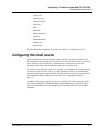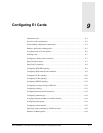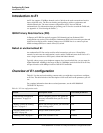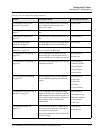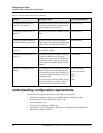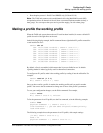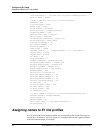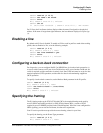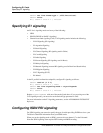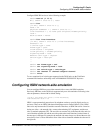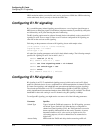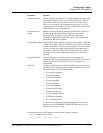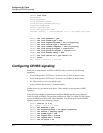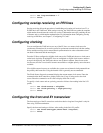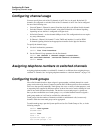
Configuring E1 Cards
Enabling a line
APX 8000/MAX TNT/DSLTNT Physical Interface Configuration Guide Preliminary May 9, 2000 9-7
admin> read e1 {1 12 0}
admin> set name = E1 Trunk
admin> write
E1/{ shelf-1 slot-12 0 } written
admin> dir e1
17 04/17/1997 19:00:02 { shelf-1 slot-12 0 } "E1 Trunk"
For E1 lines, the Line Status window displays either the name (if assigned) or the physical
address. If the name is longer than eight characters, the last character displayed is a plus sign
(+).
Enabling a line
By default each E1 line is disabled. To enable an E1 line, read its profile to make it the working
profile, then set Enabled to Yes, as in the following example:
admin> read e1 {1 2 1}
E1/{ shelf-1 slot-2 1 } read
admin> set line enabled = yes
admin> write
E1/{ shelf-1 slot-2 1 } written
Configuring a back-to-back connection
For diagnostics, you can configure DASS-2 or DPNSS lines in a back-to-back connection. A
crossover cable connects an E1 port of one TAOS unit to an E1 port of another TAOS unit. No
switch is required, and the connection is entirely local. One TAOS unit must be set up for data
terminal operation (DTE) operation, and the other for data circuit-terminating equipment
(DCE) operation.
To specify a back-to-back connection, set the Back-to-Back parameter in the E1 profile:
admin> read e1 {1 2 1}
E1/{ shelf-1 slot-2 1 } read
admin> set back-to-back = [true|false]
admin>
write
E1/{ shelf-1 slot-2 1 } written
Specifying the framing
The E1 framing mode can be G703 (G.704 with CRC4, the standard framing mode used by
most E1 ISDN and DASS2 providers) or 2DS (G.704 without CRC4, a variant of G.703
required by most E1 DPNSS providers in the United Kingdom). If the line is not configured for
ISDN signaling, you can use the D4 format, also known as superframe.
Your E1 service provider must provide the correct framing values for your lines.
To specify the framing, set the Frame-Type parameter:
admin> read e1 {1 2 1}
E1/{ shelf-1 slot-2 1 } read



